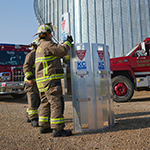Sweep auger safety
Learn how to help workers steer clear of sweep augers and other mechanical devices inside of grain bins.
Safety inside a grain bin is paramount. Grain bins remain a very dangerous place where injuries and fatalities occur when workers come into contact with mechanical devices such as sweep augers, become entrapped or engulfed in flowing grain or develop respiratory illnesses associated with breathing in too much grain dust or mold. See other grain bin hazards.
That’s why the Occupational Safety and Health Administration (OSHA) took a very strong stance to make the grain industry safer. In 1987, OSHA promulgated its Grain Handling Standard (29 CFR 1910.272) that required employers to follow specific precautions prior to and during grain bin entry.
Nationwide believes that the best safety plan for grain bins is to take steps to ensure proper grain management eliminating the hazards of out-of-condition grain that often requires workers to enter bins. If bin entry is necessary, grain bin entry planning and training is the key to doing it safely. Proper planning and training helps ensure safe-work procedures are followed and entry personnel can confidently perform their assigned tasks.
In 2009, OSHA stated through an interpretation letter that it would be considered a violation to work inside a grain bin with an energized sweep auger, unless the auger was “completely guarded.” That’s because even a partially guarded auger can easily grab a worker’s pant leg and cause serious bodily injury or death.
This new policy was considered impractical since a completely guarded auger cannot efficiently empty a bin. Prior to the letter, many augers — especially small augers — only had back guards. And top guards were only found on tractor-driven sweeps.
As a result of the new policy, many grain-handling facilities were cited for violation of failing to properly guard the auger.
To stay compliant, operators found they had to remain outside the bin and observe if a clog occurred. Then lock out the sweep auger, follow bin-entry requirements, to remove the clog, exit the bin and then restart the operation — drastically slowing down the bin-emptying process.
Following a legal challenge, OSHA issued a memorandum on May 3, 2013 that concluded operators could remain inside a grain bin with an energized sweep auger inside provided:
- The only unguarded portion of the auger is in front.
- Sub-floor augers are guarded by secure grates or other guards.
- There is an engineering control (such as a standard guard rail attached to the auger, a portable guard rail trailing seven feet behind the auger, or a dead-man switch on an operating control inside an enclosure or attached to a handle that keeps the employee seven feet back from the auger); and the facility’s bin entry permit procedures are followed.
In total, there are 10 sections to the 2013 memo addressing employee entry into bins with mobilized sweep augers. John Lee, Director of Safety Health, Grain and Feed Association of Illinois, further describes the memo and shares his thoughts in an October 2013 Newsletter Update.
It should be emphatically stated that this is not a return to the old dangerous methods. Plus, some states have a state-plan OSHA regulation system which means the program is run by a state agency and not the Federal OSHA. You should check your local regulations as it applies.
Farmers who think OSHA regulations don’t apply to smaller bins on family farms would be missing out on life saving practices. Grain bin hazards, including sweep augers, are equally present in commercial and farm bins. OSHA regulations should be used as safety guidelines to protect farm workers and family members as they are based on insurance-industry statistics and sound safety practices.
OSHA looked at investigation reports and determined the best course of action was to use both administrative controls (procedures) and engineering controls (guards, grates and switches) to reduce the risk to as low as reasonably possible. For the farmer, that translates to either shutting off the auger prior to entering or making modifications to your equipment to bring it in line with the requirements that OSHA has developed to keep people safe.
We hope you utilize the above information in developing a comprehensive sweep-auger policy, including an Effective Lockout/Tagout Program to help keep you and others safe.
The best policy is not to enter grain bins while equipment is running. If entry is essential during auger operation, follow OSHA regulations and guidance to reduce the risk of injury.

 >
>

 >
>
 >
>